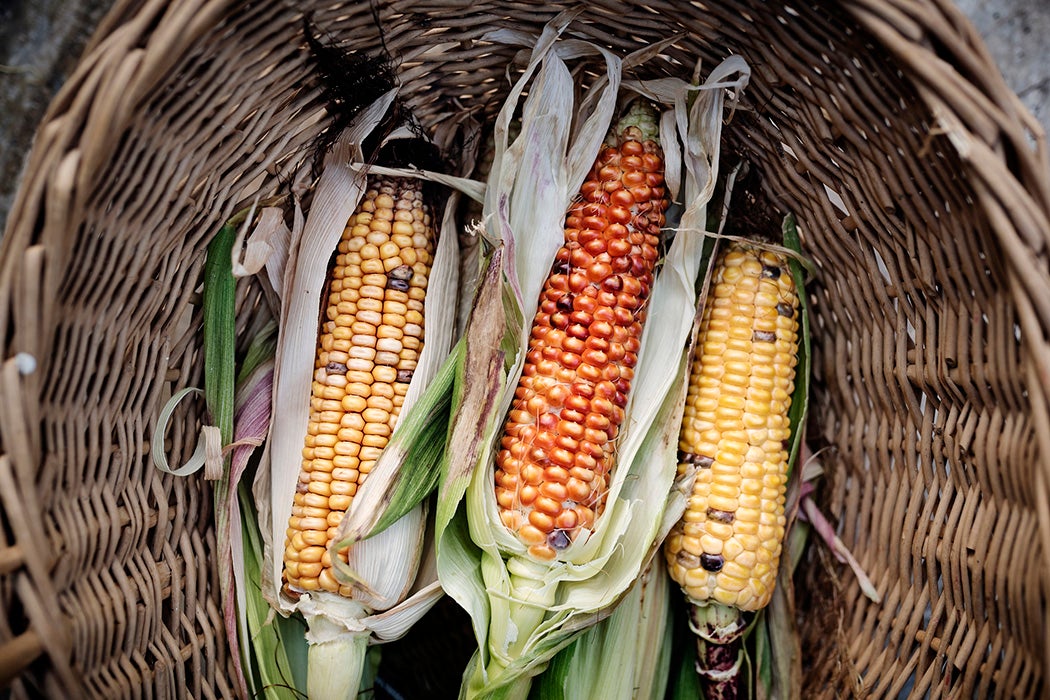Americans call it corn. Hardly anybody else does. To most of the world, corn is maize, a word from the Taíno mahiz (as transcribed by Columbus) and Latinized to mays in the scientific binomial for the plant, Zea mays. Mahiz means “life-giving seed.” Linnaeus might have been a bit redundant with the Greek zea, which also means “life-giving,” but then maize was fundamental to the diet and cultures of the Americas. It literally was life-giving and civilization-building.
In the mid 1970s, Mazola corn-oil margarine started being advertised on television with the tagline “You call it corn. We call it maize.” The line lived long enough to be remembered by young Bart Simpson in a pinch.
The “we” in the Mazola ads were supposed to be Indigenous Americans. The pitch aimed to unite nature, naturalness, and Native authenticity, arguably in response to the cultural and political ferment sparked by the American Indian Movement. But television ads aren’t a notably accurate source for cultural or culinary or any other kind of history. As corn maven Betty Fussell writes, when Columbus “discovered” maize in 1492, the plant was known by many words in some two thousand Indigenous American languages.
“Corn,” meanwhile, comes from the German korn, which in turn is rooted in the Proto-Germanic *kurnam, a grain or seed. This old usage can still be found in “corned beef,” in which the corn-ing agents are grains of salt. “Corn” and its regional European variants came to mean cereal grains. What was grown locally was what was called corn: wheat in England, oats in Scotland and Ireland, rye in Germany. (The infamous British Corn Laws of the nineteenth century, which strangled the poor and reinforced the power of landowners, aimed to control the import of wheat, oats, and barley; maize was considered animal food.)
British colonists in the Americas called maize “Indian corn” and “Turkey corn.” Both “Indian” and “Turkey” connoted savagery and barbarism; Fussell notes that the Turks also associated the plant with barbarism. At first, the English wouldn’t eat this “type of inferior wheat” and “Salvage trash.” Hunger made them change their minds.
Foodways can be particularly reactionary, but (Euro-) Americans did finally take to corn and stick with it, both gastronomically and linguistically. Other English-speakers prefer “maize” to avoid confusion. Canned corn in American food relief shipments to war-shattered Europe was supposedly rejected on the grounds that it was considered to be animal fodder.
Fussell notes that there’s another factor in the American translation of maize into corn.
“In changing the meaning of the word ‘staple’ from a cereal grain to land and its cash equivalent, America’s colonists commodified the earth,” she writes.
Corn, with its “innate potential for kernel volume,” was turned into a “goldmine for the industrial age.” Factory farming and industrial food production, tied to petrochemicals and bioengineering, have turned corn into a commodity. In fact, very little corn is directly eaten by consumers, but the stuff is ubiquitous, interwoven throughout civilization. (We are all very much the children of corn.) “Anything made from a barrel of petroleum can be made from corn” proclaimed the National Corn Growers Association in 1987. The list is mind-boggling: insecticides, tires, shotgun shells, talcum powder, embalming fluid, ethanol, and so on.
Get our weekly newsletter
“If eating food is our primary act of translation, it is also our most complexly civilized one in relating word to thing through the portal of the mouth,” writes Fussell, who has also authored The Story of Corn. Of course, you have to get that translation right. Columbus didn’t know anything about nixtamalization, the alkali-processing of corn developed over centuries by Indigenous Americans. Slaking corn with lime makes available vital nutrients, including niacin (vitamin B3). A diet reduced to untreated cornmeal, which became a staple of the poor across Europe and Africa, results in “corn sickness” or pellagra. The disease was notably unknown to Indigenous Americans.
Editor’s Note: The final paragraph of this story was amended to clarify the purpose of slaking corn with lime.
Support JSTOR Daily! Join our membership program on Patreon today.







